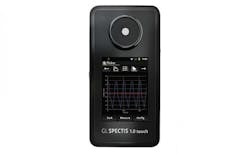The GL Spectis 1.0 Touch Flicker Spectrometer is an upgraded version of the very successful handheld Spectis 1.0 Touch Spectral Light Meter. This device can now measure the increasingly important parameter of light flicker in addition to the extensive range of standard photometric and colorimetric values already available. The Spectis 1.0 Touch Flicker Spectrometer is now equipped with additional electronics and a fast photodiode to measure flicker frequency, flicker index, and flicker ratio. Designed and developed in consultation with industry leaders and standards committees, this device provides all the measurement quantities required to accurately measure and understand flicker.
With LED lighting applications, the problem of flicker in a slow-motion video has resurfaced. Previously, this was a very common phenomenon with fluorescent lighting, but as technical improvements were made to the ballasts, the problem was largely eliminated. Today the main source of such flicker is LED lighting, caused by the driving circuitry supplying power to the lights. For sports facilities, having optimal illumination with minimal light flicker is important to consider when installing LED lighting. For instance, at FC Chelsea's famous Stamford Bridge Stadium (Fulham, London, UK) the existing lighting was recently replaced with LED fixtures that can create unique illumination effects and light displays.
The mobile GL Spectis 1.0 Touch Flicker spectrometer from GL Optic is suitable for measuring flicker in the signal range 0.1Hz – 12.5kHz. The user can take measurements of light sources and LED floodlights. To fully characterize and compare light sources, the GL Spectis 1.0 T Flicker can process recognized flicker parameters such as flicker frequency, flicker index and flicker factor. The instrument can also be used to capture other photometric and colorimetric data such as illuminance, colorimetric locus and color rendering index, displaying the analysis results on the color touchscreen. The GL Spectis 1.0 Touch Flicker can be used to detect, characterize, and ultimately avoid flicker issues. Covering an exceptionally wide range of frequencies, this device offers accuracy equal to many laboratory devices.
Flicker-free lighting is extremely important for slow-motion replays that show home TV viewers exactly what happened, something which is now taken for granted in professional sports. At frame rates up to 480 fps for slow-motion sequences, modulation of the artificial light output can produce perceptible brightness variations. Normally, up to a certain frequency, human persistence of vision compensates for light modulation, which is why fluctuations in light caused by the alternating current powering lights are not normally noticed. During the planning and design phase, the use of a professional light meter like this is essential to verify the proposed lighting system has minimal flicker.





